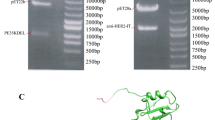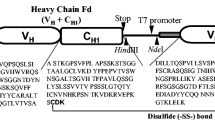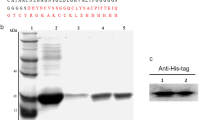Abstract
The HER2/neu proto-oncogene encodes a 185-kDa trans-membrane glycoprotein kinase with extensive homology to the epidermal growth factor receptor and plays a key role in the transformation and growth of malignant tumors. To date, two antibody drugs targeting HER2/neu have been developed successfully. In order to reduce the cost and the time of clinical treatment, we produced a fusion protein composed of human beta defensin 2 (hBD2) and anti-HER2/neu single-chain variable fragment (scFv 4D5), which is capable of specifically targeting, significantly inhibiting, and promptly killing HER2/neu-positive cancer cells. The recombinant protein was expressed in Escherichia coli using the small ubiquitin-related modifier (SUMO) as the molecular chaperone, and the optimal expression level reached to 40.2 % of the total supernatant protein. After purifying by Ni-NTA affinity chromatography, the fusion protein was cleaved with a SUMO-specific protease to obtain hBD2–4D5, which was further purified by Ni-NTA affinity chromatography. The purity of hBD2–4D5 was higher than 95 %, and the yield was 19 ± 2 mg/L in flask fermentation. The cell number count and flow cytometry results showed that hBD2–4D5 exerted cytotoxic and anti-proliferative effects on HER2/neu-positive breast cancer cell line, SKBR-3. The results of scanning electron microscope and transmission electron microscope observation indicated that hBD2–4D5 could induce intracellular ultrastructure changes and cell necrosis by disrupting the cell membrane. Immunofluorescence analysis showed that hBD2–4D5 could bind to SKBR-3 cells and further be internalized into the cytoplasm. Moreover, hBD2–4D5 could also mediate apoptosis of SKBR-3 cells by up-regulating the ratio of Bax to Bcl-2.









Similar content being viewed by others
References
Asano R, Sone Y, Makabe K, Tsumoto K, Hayashi H, Katayose Y, Unno M, Kudo T, Kumagai I (2006) Humanization of the bispecific epidermal growth factor receptor CD3 diabody and its efficacy as a potential clinical reagent. Clin Cancer Res 12:4036–4042
Biragyn A, Surenhu M, Yang D, Ruffini PA, Haines BA, Klyushnenkova E, Oppenheim JJ, Kwak LW (2001) Mediators of innate immunity that target immature, but not mature, dendritic cells induce antitumor immunity when genetically fused with nonimmunogenic tumor antigens. J Immunol 167:6644–6653
Bowdish DM, Davidson DJ, Hancock RE (2006) Immunomodulatory properties of defensins and cathelicidins. Curr Top Microbio Immunol 306:27–66
Bruell D, Stöcker M, Huhn M, Redding N, Küpper M, Schumacher P, Paetz A, Bruns CJ, Haisma HJ, Fischer R, Finnern R, Barth S (2003) The recombinant anti-EGF receptor immunotoxin 425 (scFv)-ETA′ suppresses growth of a highly metastatic pancreatic carcinoma cell line. Int J Oncol 23:1179–1186
Butt TR, Edavettal SC, Hall JP, Mattern MR (2005) SUMO fusion technology for difficult-to-express proteins. Protein Expr Purif 43:1–9
Chen X, Niyonsaba F, Ushio H, Hara M, Yokoi H, Matsumoto K, Saito H, Nagaoka I, Ikeda S, Okumura K, Ogawa H (2007) Antimicrobial peptides human beta-defensin (hBD)-3 and hBD-4 activate mast cells and increase skin vascular permeability. Eur J Immunol 37:434–444
Corrales-Garcia LL, Possani LD, Corzo G (2011) Expression systems of human β-defensins: vectors, purification and biological activities. Amino Acids 40:5–13
Coussens L, Yang-Feng TL, Liao YC, Chen E, Gray A, McGrath J, Seeburg PH, Libermann TA, Schlessinger J, Francke U (1985) Tyrosine kinase receptor with extensive homology to EGF receptor shares chromosomal location with neu oncogene. Science 230:1132–1139
Fadnes B, Rekdal O, Uhlin-Hansen L (2009) The anticancer activity of lytic peptides is inhibited by heparin sulfate on the surface of the tumor cells. BMC Cancer 9:183
Ganz T (2003) Defensins: antimicrobial peptides of innate immunity. Nature Rev Immunol 3:710–720
Harder J, Bartels J, Christophers E, Schroder JM (1997) A peptide antibiotic from human skin. Nature 387:861
Huang Y, Su Z, Li Y, Zhang Q, Cui L, Su Y, Ding C, Zhang M, Feng C, Tan Y, Feng W, Li X, Cai L (2009) Expression and purification of GST-SUMO-MT fusion protein, and its neuronal and hepatic protection against d-galactose-induced oxidative damage in mouse model. J Pharmacol Exp Ther 329:469–478
Jung S, Mysliwy J, Spudy B, Lorenzen I, Reiss K, Gelhaus C, Podschun R, Leippe M, Grotzinger J (2011) Human beta-defensin 2 and beta-defensin 3 chimeric peptides reveal the structural basis of the pathogen specificity of their parent molecules. Antimicrob Agents Chemother 55:954–960
Kohlgraf KG, Ackermann A, Lu X, Burnell K, Bélanger M, Cavanaugh JE, Xie H, Progulske-Fox A, Brogden KA (2010) Defensins attenuate cytokine responses yet enhance antibody responses to Porphyromonas gingivalis adhesins in mice. Future Microbiol 5:115–125
Kubo M, Morisaki T, Kuroki H, Tasaki A, Yamanaka N, Matsumoto K, Nakamura K, Onishi H, Baba E, Katano M (2003) Combination of adoptive immunotherapy with Herceptin for patients with HER2-expressing breast cancer. Anticancer Res 23:4443–4449
Lichtenstein A, Ganz T, Selsted ME, Lehrer RI (1986) In vitro tumor cell cytolysis mediated by peptide defensins of human and rabbit granulocytes. Blood 68:1407–1410
Liu L, Roberts AA, Ganz T (2003) By IL-1 signaling, monocyte-derived cells dramatically enhance the epidermal antimicrobial response to lipopolysaccharide. J Immunol 170:575–580
Ma XT, Xu B, An LL, Dong CY, Lin YM, Shi Y, Wu KF (2006) Vaccine with beta-defensin 2 transduced leukemic cells activates innate and adaptive immunity to elicit potent antileukemia responses. Can Res 66:1169–1176
Ma C, Li Y, Li Z, Huang H, Xu K, Xu H, Bai J, Li X, Zhao G (2012) Synthesis and purification of a toxin-linked conjugate targeting epidermal growth factor receptor in Escherichia coli. Protein Expr Purif 83:1–7
Markeeva N, Lysovskiy I, Zhuravel E, Soldatkina M, Lyzogubov V, Usenko V, Potapov V, Pogrebnoy P (2005) Involvement of human beta-defensin-2 in proliferation of transformed cells of human cervix. Exp Oncol 27:308–313
Moulder SL, Arteaga CL (2003) A phase I/II trial of trastuzumab and gefitinib in patients with metastatic breast cancer that overexpresses HER2/neu (ErbB-2). Clin Breast Cancer 4:142–145
Niyonsaba F, Ogawa H, Nagaoka I (2004) Human beta defensin-2 functions as a chemotactic agent for tumour necrosis factor-alpha-treated human neutrophils. Immunology 111:273–281
Oren A, Ganz T, Liu L, Meerloo T (2003) In human epidermis, beta-defensin 2 is packaged in lamellar bodies. Exp Mol Pathol 74:180–182
Pazgiera M, Hooverb DM, Yang D, Lu W, Lubkowski J (2006) Human β-defensins. Cell Mol Life Sci 63:1294–1313
Press MF, Pike MC, Hung G, Zhou JY, Ma Y, George J, Dietz-Band J, James W, Slamon DJ, Batsakis JG (1994) Amplification and overexpression of HER-2/neu in carcinomas of the salivary gland: correlation with poor prognosis. Cancer Res 54:5675–5682
Selsted ME, Ouellette AJ (2005) Mammalian defensins in the antimicrobial immune response. Nat Immunol 6:551–557
Semple F, Webb S, Li HN, Patel HB, Perretti M, Jackson IJ, Gray M, Davidson DJ, Dorin JR (2010) Human beta-defensin 3 has immunosuppressive activity in vitro and in vivo. Eur J Immunol 40:1073–1078
Tsutsumi SH, Suzuki K, Akahori Y (2011) Antibody-dependent cell-mediated cytotoxicity is induced by a single-chain Fv–protein III fusion in the presence of a rabbit anti-protein III polyclonal antibody. Immunol Letters 136:44–48
Verri E, Guglielmini P, Puntoni M, Perdelli L, Papadia A, Lorenzi P, Rubagotti A, Ragni N, Boccardo F (2005) HER2/neu oncoprotein overexpression in epithelial ovarian cancer: evaluation of its prevalence and prognostic significance. Clinical study Oncology 68:154–161
Wang YS, Wang GQ, Wen YJ, Wang L, Chen XC, Chen P, Kan B, Li J, Huang C, Lu Y, Zhou Q, Xu N, Li D, Fan LY, Yi T, Wu HB, Wei YQ (2007) Immunity against tumor angiogenesis induced by a fusion vaccine with murine beta defensin 2 and mFlk-1. Clin Cancer Res 13:6779–6787
Winter J, Wenghoefer M (2012) Human defensins: potential tools for clinical applications. Polymers 4:691–709
Yang D, Chertov O, Bykovskaia SN, Chen Q, Buffo MJ, Shogan J, Anderson M, Schroder JM, Wang JM, Howard OM, Oppenheim JJ (1999) Beta-defensins: linking innate and adaptive immunity through dendritic and T cell CCR6. Science 286:525–528
Acknowledgments
This work was supported by grant of the Science Foundation of Wenzhou in China (No. Y20090279), grant of Guangdong Provincial Department of Science and Technology (No. 2009B080701090), the Program for New Century Excellent Talents in University (NCET-08-0611) and the Academy of Sciences comprehensive strategic cooperation of Guangdong Province in China (No. 2010B090301016).
Conflict of interest
The authors declare that they have no conflict of interest.
Author information
Authors and Affiliations
Corresponding authors
Additional information
Minjing Zhang and Zhuangwei Qiu contributed equally to this study.
Rights and permissions
About this article
Cite this article
Zhang, M., Qiu, Z., Li, Y. et al. Construction and characterization of a recombinant human beta defensin 2 fusion protein targeting the epidermal growth factor receptor: in vitro study. Appl Microbiol Biotechnol 97, 3913–3923 (2013). https://doi.org/10.1007/s00253-012-4257-z
Received:
Revised:
Accepted:
Published:
Issue Date:
DOI: https://doi.org/10.1007/s00253-012-4257-z




